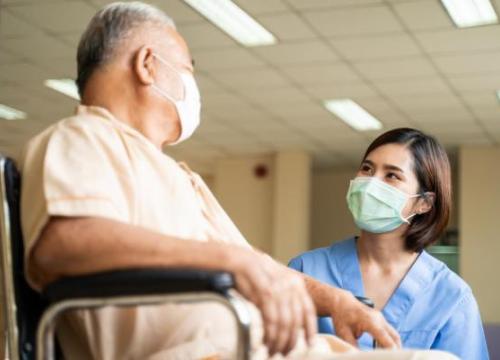Low Blood Pressure and PD
Parkinson’s disease (PD) not only affects movement; it also affects the autonomic nervous system, which controls and regulates many automatic bodily functions — such as breathing, digestion and body temperature — without us needing to think about them. One of these functions is blood pressure. When we get out of bed or stand up from a chair, our blood pressure drops. To keep blood pressure in check, the nervous system releases a chemical called norepinephrine, which causes our blood vessels to tighten, sending blood from the legs and trunk up to the brain, the “control center” of the body.
People with PD often have lower amounts of norepinephrine. Because of this deficiency, blood pressure may not return to normal immediately after standing, resulting in fatigue, dizziness or even fainting. This type of low blood pressure — caused by a change in position — is called orthostatic hypotension (OH). When it is related to a nervous system disease, like Parkinson’s, it is also referred to as neurogenic orthostatic hypotension (nOH).
Orthostatic Hypotension (OH) is a form of low blood pressure that happens when standing after sitting or lying down.
Symptoms of orthostatic hypotension can include:
- Lightheadedness
- Dizziness
- Fainting
- Falls
- Weakness
- Foggy thinking
- Headache
- Trembling
- Nausea
- Cold hands and feet
- Chest/shoulder pain
- Vision changes
To check for OH, your doctor should take three blood pressure readings: laying down, within 1 minute after standing, after standing for 3 minutes.
Causes of Orthostatic Hypotension
In addition to PD itself, the medications used to treat PD can contribute to OH. Other medications can lower blood pressure as well. These include some antidepressants, diuretics (water pills), drugs for urinary problems and erectile dysfunction and, of course, medications used to treat high blood pressure.
Heart disease, fever, anemia (low red blood cell count) and dehydration can also lower blood pressure. Dehydration is particularly important to watch out for. When people are dehydrated, their body water decreases. Low body water means less circulating blood, which generally leads to low blood pressure.
Diagnosis of Orthostatic Hypotension
If you feel symptoms such as lightheadedness, dizziness or weakness when you stand up after sitting or lying down, you may be experiencing orthostatic hypotension. Your doctor can measure your blood pressure to test for the condition — defined by a drop of at least 20 millimeters of mercury in systolic blood pressure (top number) and 10 millimeters of mercury in diastolic blood pressure (bottom number) within three minutes after standing up.
Treatment of Orthostatic Hypotension (OH)
This condition can put people with Parkinson’s at risk of fainting, losing balance and falling. Recognizing the signs of OH is key to developing strategies to prevent falls, which can result in serious injuries. Stay hydrated by drinking fluids, especially during hot- weather months. Also, when getting out of bed or standing up from a chair, move slowly to give your body time to adjust.
In addition, ask your doctor to review your medications and identify any that may be lowering your blood pressure. Your doctor may decide to reduce the dose of a medication or even eliminate it if no longer needed.
Talk to your doctor about medications that can help you reduce OH symptoms. Be aware that medications that raise low blood pressure to normal levels when a person is standing may cause high blood pressure when a person is lying down. There may be additional side effects to discuss with your doctor.
Managing Orthostatic Hypotension
- Drink lots of water – at least one cup (8 ounces) with meals and several more throughout the day. Check with your doctor for the right amount for you.
- Practice regular, gentle exercise and avoid long periods of inactivity.
- Work with a physical or occupational therapist to learn exercises that increase blood flow to the heart.
- Eat small, frequent meals. Reduce alcohol and avoid hot drinks and hot foods.
- After consulting your doctor, increase your salt intake by eating prepared soups or pretzels. Note: People with heart disease should avoid this.
- If you expect to be standing for a long period of time, drinking two 8-ounce glasses of cold water quickly will increase blood volume and blood pressure will go up.
- Try wearing thigh or waist-high compression stockings or an abdominal binder.
- Move slowly from lying to sitting and then standing.
- Avoid overheating by limiting your exposure to midday sun during warmer months, very hot showers, hot tubs, saunas, etc.
If you feel dizzy or like you might faint or fall, sit back down immediately – even if you have to sit on the floor.
Related Materials
Related Blog Posts


How To Stay Safe During a Hospitalization with Parkinson’s
